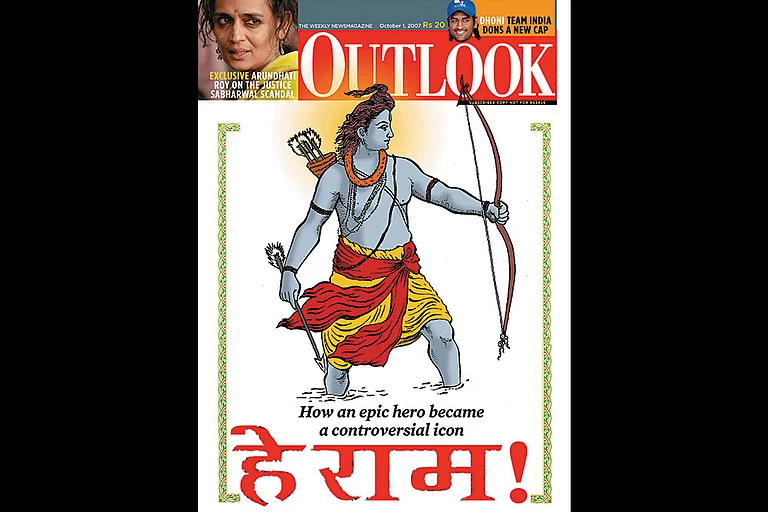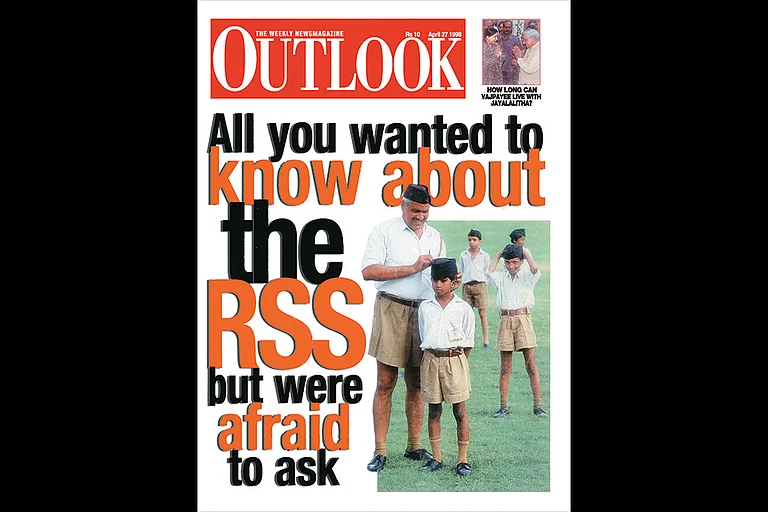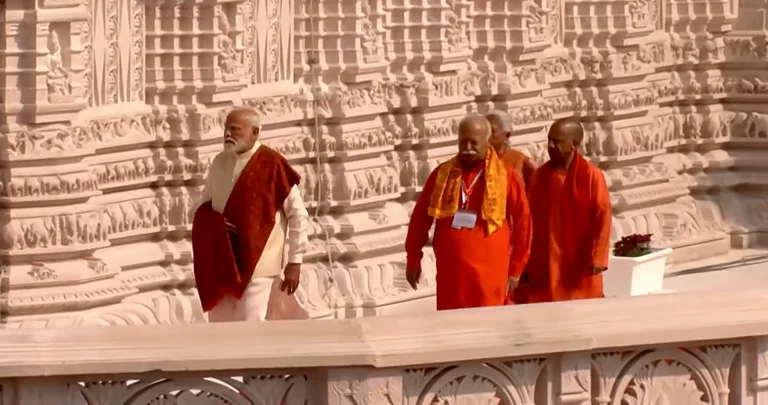The installation of the idol of Ram Lalla in the sanctum sanctorum of the Ram temple at Ayodhya, and the subsequent pran-pratishtha ceremony that took place on 22 January 2024 marks the symbolic commencement of a new era in Indian history – the commencement of ‘Ram Rajya,’ the supposed paradigm of righteous and benevolent governance.
The concept of ‘Ram Rajya’ (the ‘Kingdom of Rama’ or the ‘Reign of Rama’) embodies righteous leadership guided by dharma, justice, fairness, and empathy. This idyllic mythical era, as depicted in the Ramcharitmanas, was one of immense prosperity and universal happiness, where sorrows vanished under the ideal and benevolent reign of King Rama.
The concept of Ram Rajya thus encapsulates the Hindu vision of a utopian India. Rooted in the virtues of King Rama, the protagonist of the Indian epic, The Ramayana, the concept envisions an exemplary society. Influenced by the teachings of the Ramayana, Mahatma Gandhi introduced the concept of ‘Ram Rajya’ into our national discourse. He envisioned independent India in terms of Ram Rajya. Explaining his concept of ‘Ram Rajya’ in his 1927 book, Young India 1924-1926, Gandhi said, “By Ram Rajya I do not mean Hindu Raj. I mean Ram Raj, the kingdom of God. For me, Ram and Rahim are one and the same; I acknowledge no other God than the one God of Truth and righteousness. Whether Ram of my imagination ever lived on this earth, the ancient ideal of the Ramayana is undoubtedly one of true democracy in which the meanest citizen could be sure of swift justice without an elaborate and costly procedure.”
The emergence of a robust Hindu nationalist consciousness in recent times, however, has led to reimagining and reinterpreting the notion of ‘Ram Rajya’ on the lines of a ‘Hindu Rashtra’ – a state prioritizing the Hindu majority over other religious minorities. The religiously neutral Gandhian concept has been appropriated by the discourse of ‘Hindutva’ – an ideology that is deeply grounded in Hindu religious, cultural, and political aspirations.
Some significant events in recent Indian history serve as markers of this transition from the Gandhian discourse of ‘Ram Rajya’ to that of a ‘Hindu Rashtra’: the reported enigmatic appearance of the idol of Ram Lalla inside the Babri Masjid on the night of 22-23 December 1949; LK Advani’s 1990 rath yatra – a religious rally with political undertones – from Somnath to Ayodhya to mobilize support for the construction of the Ram temple, and the subsequent demolition of the Babri Masjid in 1992 by the kar sevaks; the 2019 Supreme Court verdict settling the land dispute at Ayodhya in favour of the Ram temple – a verdict based on a compromise formula that some its critics argue undermines the secular ethos of India. The construction of the Ram temple at Ayodhya is seen by many as the fulfilment of a long-cherished Hindu dream and as a potent symbol of Hindu religious, cultural and political ascendancy. It is an aspect of the same dream that is reflected in the proposal to change India’s official name from India to ‘Bharat.’
These markers align with the increasing Hindu nationalist rhetoric, with its most aggressive form being the fervent chanting of ‘Jai Shri Ram.’ The slogan gained prominence during LK Advani’s rath yatra, where it was strategically used to evoke Hindu sentiments and garner support for the construction of the Ram temple. ‘Jai Shri Ram’ is a reimagined version of ‘Hey Ram,’ Gandhi’s final words, before he succumbed to the bullets of his assassin. Today, many in India look upon the Ram temple at Ayodhya as the most powerful symbol of this supposed national aspiration centred on the concept of Hindu Rashtra. While the larger majority of Indians believed that by laying the foundation stone of the Ram temple on 5 August 2020 Prime Minister Narendra Modi laid the foundations of a new ‘Ram Rajya,’ to a sizeable section of the Indian population the same act symbolized laying the foundation for a Hindu Rashtra.
Every discourse is subject to interpretations; and Gandhi’s discourse on Ram Rajya has been reimagined and reinterpreted in favour of a Hindu Rashtra, to suit a certain ideology and agenda. One need not be surprised, therefore, if Gandhi’s other observations on Lord Rama too get new interpretations in the days to come. During his visit to Ayodhya in 1915, Gandhi addressed a gathering of sadhus at the bank of river Sarayu. He conscientized them on the importance of a healthy relationship between Hindus and Muslims and discussed the question of cow protection alongside the question of protection of the weak and vulnerable in society. Talking about love, he told them, “We need to learn to love the way Rama loved Sita.”
Gandhi’s comment on Rama’s love for Sita, while intriguing, reveals the inherent complexities and interpretive nuances within the portrayal of their relationship in the Ramayana. Despite Rama being revered as a righteous king, his treatment of Sita has raised several questions. Critics challenge the agnipariksha (fire ordeal) he imposes on Sita – a woman who emerged from Ravana’s captivity ravaged by suffering and trauma – viewing it as an unjust demand rooted in male chauvinism and patriarchal expectations of female chastity. According to their perspective, Rama, by prioritizing societal perceptions over Sita’s well-being, demonstrates a troubling tendency to value her purity more than her individuality and personal rights.
As the story goes, soon after assuming the throne of Ayodhya, Rama found himself haunted by the lingering public doubts regarding the paternity of his unborn child, all sparked by a gossipy washerwoman. Succumbing once again to public pressure, and his perceived sense of duty to his country, he took the difficult and debatable decision to exile his devoted and loyal wife to the forest. In doing so, Rama prioritized the opinions of his subjects over his trust in and duty to his wife – a wife who had already proved her purity through an agnipariksha earlier, after having been rescued by her husband from the clutches of Ravana.
It is important to remember that Rama and Sita were not ordinary mortals; Rama was a God, the incarnation of Shiva; and Sita was a goddess, the incarnation of Lakshmi. Therefore, one wonders if even in his divine status, Rama could not challenge the prejudices ingrained in a patriarchal society by fulfilling his duty towards his wife without succumbing to public pressure during critical moments, what insights should Indian husbands derive from Rama as a spouse? What lessons ought Indian citizens glean from Rama as a God, and what guidance does Rama’s example offer to Indian leaders who aspire to rule as the titular heroes of a new Ram Rajya?
It appears rather ironic that Rama strove to ensure the safety, security, happiness and wellbeing of his subjects at the expense of a venerable and blameless woman – his wife, and queen of his kingdom. Adding to the irony, the ashvamedhayagna that he undertook to ensure the security and prosperity of his kingdom and assert his imperial dominance required him to have his queen by his side. Apart from being the symbol of imperial dominance, the grand yagna also served as a symbol of conjugal harmony, a reflection of the kingdom’s wellbeing. When the priests attempted to resolve the issue by advising Rama to remarry, he commissioned a golden effigy of Sita to occupy the queen’s seat during the ceremony, ensuring that the traditional requirements of the sacrificial ritual were met.
When the unchallenged royal horse of the yagna was captured by Sita’s young sons Luv and Kush, indicating their royal parentage, and when the people of Ayodhya, realizing their earlier mistake, implored Sita to return as their queen, Rama insisted that Sita undergo another agnipariksha to re-affirm her purity to the nation before her reinstatement to the throne. Weary of the repeated requirement to prove her chastity to the public, Sita prayed to Mother Earth that if she had indeed stayed loyal and devoted to her husband, the earth must split open and consume her. In an instant, the earth opened up; and bathed in an ethereal light, Sita disappeared into its depths, putting an end to her endless humiliation and trials by fire.
Despite all the justifications that can be made in support of Rama’s treatment of Sita, the heart of the original Ram Rajya unfolds a tragic narrative – two children losing their mother, a husband losing his beloved wife, a king and a kingdom losing their queen.
When the Ram Rajya of our mythical past harbours such unresolved questions and paradoxes within itself, can the reimagined version of Ram Rajya as Hindu Rashtra, driven by a politically, culturally, and religiously charged Hindutva ideology, offer a better country and society for Indians? Can the envisioned Hindu Rashtra, projected as the ideal Indian state, successfully navigate and overcome the paradoxes inherent in the idealized Ram Rajya of yore? We Indians must ask these questions at this pivotal point in our nation’s emerging history.
As Indians, our aspiration should not be to construct our nation solely based on ancient narratives or their selectively reimagined versions. Instead, our endeavour should be to build a nation where justice, safety, harmony, and respect for all, rather than just a chosen few, prevail. This quest can only be realized by governing the nation according to the principles outlined in our hallowed document – the Constitution of India.
The author is an assistant professor in the department of English at St. Xavier's College, Kolkata.





















